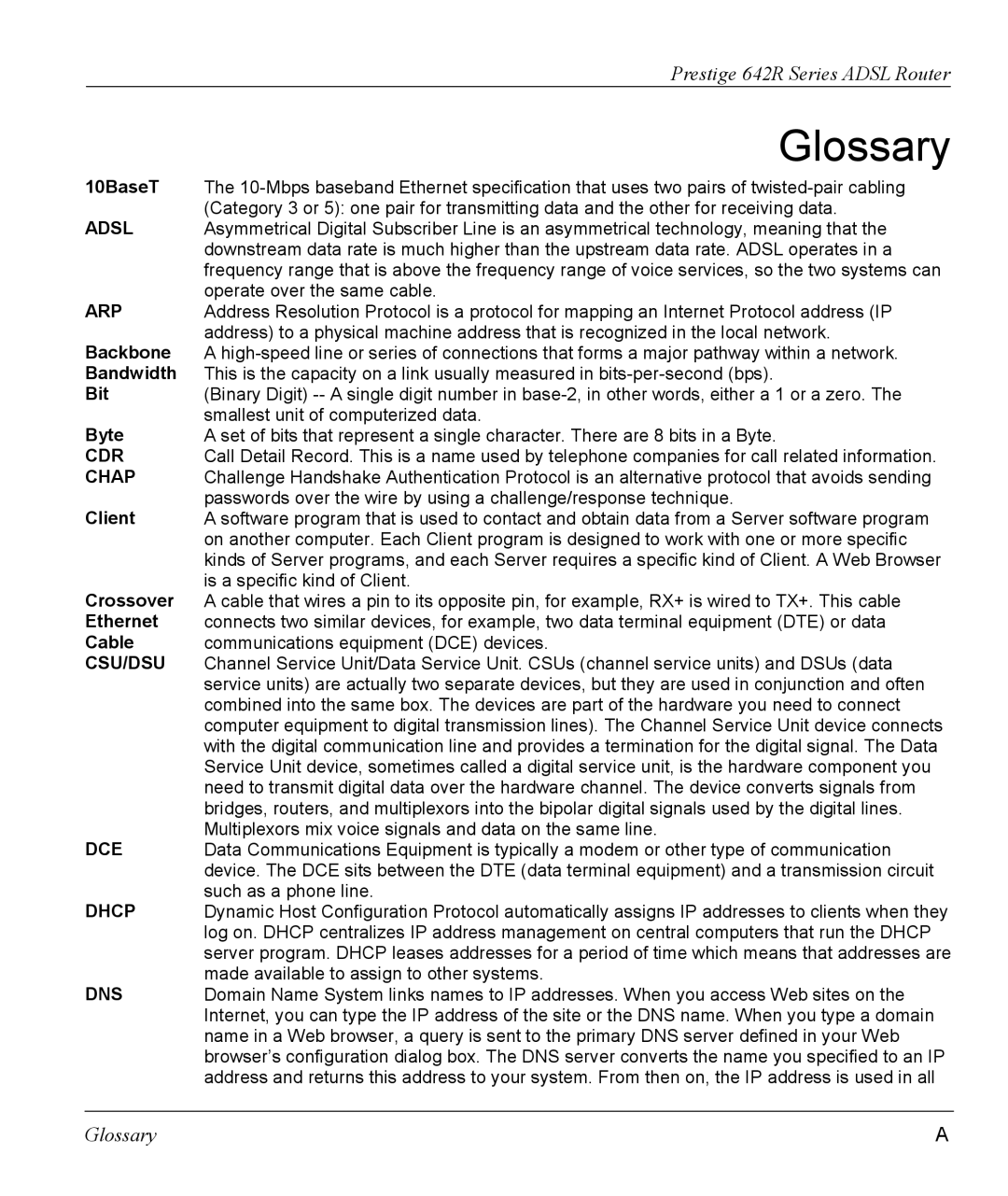| Prestige 642R Series ADSL Router |
10BaseT | Glossary |
The | |
ADSL | (Category 3 or 5): one pair for transmitting data and the other for receiving data. |
Asymmetrical Digital Subscriber Line is an asymmetrical technology, meaning that the | |
| downstream data rate is much higher than the upstream data rate. ADSL operates in a |
| frequency range that is above the frequency range of voice services, so the two systems can |
ARP | operate over the same cable. |
Address Resolution Protocol is a protocol for mapping an Internet Protocol address (IP | |
Backbone | address) to a physical machine address that is recognized in the local network. |
A | |
Bandwidth | This is the capacity on a link usually measured in |
Bit | (Binary Digit) |
Byte | smallest unit of computerized data. |
A set of bits that represent a single character. There are 8 bits in a Byte. | |
CDR | Call Detail Record. This is a name used by telephone companies for call related information. |
CHAP | Challenge Handshake Authentication Protocol is an alternative protocol that avoids sending |
Client | passwords over the wire by using a challenge/response technique. |
A software program that is used to contact and obtain data from a Server software program | |
| on another computer. Each Client program is designed to work with one or more specific |
| kinds of Server programs, and each Server requires a specific kind of Client. A Web Browser |
Crossover | is a specific kind of Client. |
A cable that wires a pin to its opposite pin, for example, RX+ is wired to TX+. This cable | |
Ethernet | connects two similar devices, for example, two data terminal equipment (DTE) or data |
Cable | communications equipment (DCE) devices. |
CSU/DSU | Channel Service Unit/Data Service Unit. CSUs (channel service units) and DSUs (data |
| service units) are actually two separate devices, but they are used in conjunction and often |
| combined into the same box. The devices are part of the hardware you need to connect |
| computer equipment to digital transmission lines). The Channel Service Unit device connects |
| with the digital communication line and provides a termination for the digital signal. The Data |
| Service Unit device, sometimes called a digital service unit, is the hardware component you |
| need to transmit digital data over the hardware channel. The device converts signals from |
| bridges, routers, and multiplexors into the bipolar digital signals used by the digital lines. |
DCE | Multiplexors mix voice signals and data on the same line. |
Data Communications Equipment is typically a modem or other type of communication | |
| device. The DCE sits between the DTE (data terminal equipment) and a transmission circuit |
DHCP | such as a phone line. |
Dynamic Host Configuration Protocol automatically assigns IP addresses to clients when they | |
| log on. DHCP centralizes IP address management on central computers that run the DHCP |
| server program. DHCP leases addresses for a period of time which means that addresses are |
DNS | made available to assign to other systems. |
Domain Name System links names to IP addresses. When you access Web sites on the | |
| Internet, you can type the IP address of the site or the DNS name. When you type a domain |
| name in a Web browser, a query is sent to the primary DNS server defined in your Web |
| browser’s configuration dialog box. The DNS server converts the name you specified to an IP |
| address and returns this address to your system. From then on, the IP address is used in all |
Glossary | A |
